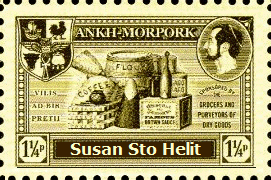|
Susan Sto Helit is both DEATHâs grand-daughter and Duchess of Sto Helit, inheriting her title on the demise of her parents. The familiar image of her, by David Wyatt, has appeared on three Sto Helit issues.
The first Sto Helit stamp was the five pence issued in the Year of the Signifying Frog. Designed and nicely proportioned by Colin Edwards.
The stamps were printed by Teemer and Spools in sheets of 42. The was a sport on the sheet where the omega on Susanâs pendant is inverted. But apart from one curiosity there seems to no other varieties. This curiosity is a early design test print done with a laser printer on ungummed paper and scissor cut. It is essentially the final design, but noticably paler and lacks the richness of colour. This item was found in a âlucky dipâ bag of loose stamps.
|
The Omega Sport |
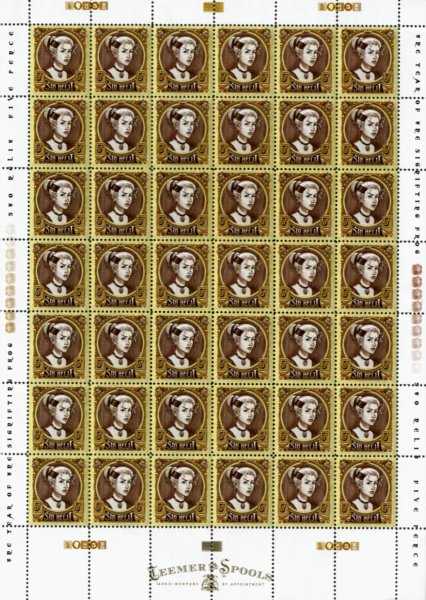
|
|
The trial print |
|
To mark the release of The Hogfather film a special stamp was required. Susan plays a major role in the film, so the Sto Helit 5p was recreated as a green version. This would be a limited edition of just 500 stamps, and they would only be available in the Winter Warmer LBE towards the end of the Year of the Signifying Frog.
The revamp was a bit more than a simple recolouring of all the components. The original had a range of browns and yellow, but this is uniformly an emerald shade. The background no longer gradates from left to right, and is uniform green.
This is where things get interesting! The sheet (not available to collectors generally and probably only as a really limited prize) still has 42 stamps, but five of them are inverted. When the sheets were split to put into the LBEs the inverted stamps were left attached to a normal stamp creating a tĂȘte-bĂȘche pair. These pairs could be horizontally or vertically arranged. As, in theory, twelve sheets would be required to supply 500 stamps there would be just twelve omega sports, but in practice with tĂȘte-bĂȘche pairs being included the number be may thirteen or even fourteen.
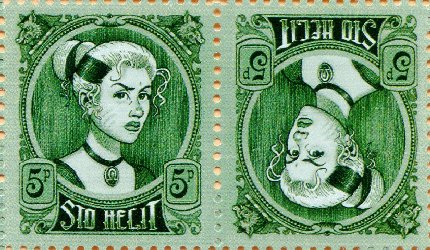
A horizontal tĂȘte-bĂȘche pairing
One of these inverted stamps held the inverted omega sport (which was used on the original stamp). Perhaps this was done to make it a little harder to find; an inverted omega on an inverted image is the right way up, and so would look normal.
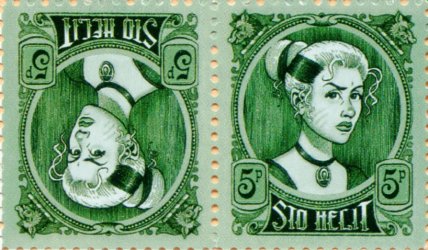
The Omega Sport tĂȘte-bĂȘche paring
But what happens when a stamp designer decides to go a little further than normal, and no-one notices? In 2013 it was revealed that a second undetected sport existed where the pillows under the boarsâ heads are reversed. Then in early 2016 a further three were made public. These new sports were missing boarsâ nostrils, missing triangle from the frame circle, and a fatter omega loop.
|
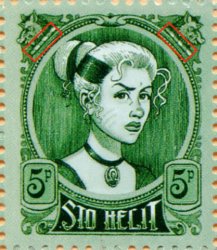
The pillow sport
|
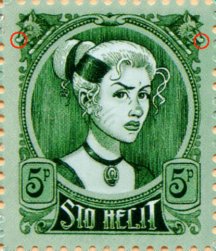
The nostrils sport
|
|
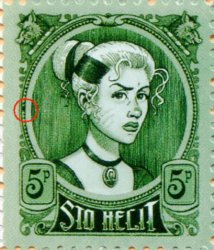
The triangle sport
|
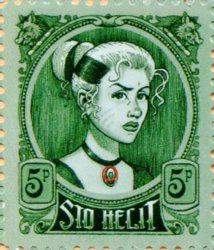
The fat omega sport
|
|
Click images for a larger view
|
|
There will also be 12 or 13 of each of these sports except for the pillow sport. This was present twice on the sheet and so there will be 24 or 26, plus the two that came up for sale in 2013. However because these were not recognised at the time of issue there will be collectors who possess one (or more) but have since retired from the hobby; the collection may be just lying somewhere unlooked at for several years and so the collector may hold a real rarity and be unaware of it.
This brings on philosophical thoughts. On release it seems to have been assumed that once the Omega sport had been found that there was nothing else; that is the general pattern although six sports of the original $1 Tower of Art stamp were known. To find one of the sports a collector would also have to have a common stamp to compare against - less likely when the stamp is a limited edition of 500. So were these extra sports known before being âoutedâ, and if so, why was the information suppressed? That could be because collectors hoped to obtain one from an unwitting seller. The images on an online auction could reveal a sport being sold as a common. Such a purchase could be to add to a collection, or could be resold as a newly 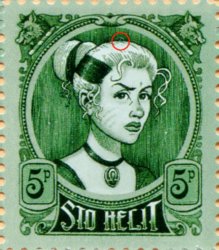 discovered uber-rare sport for serious money. Or was it the case that these were known, but assumed to be print flaws. This could well apply to three of the new sports but not the pillow sport. That had to be a deliberate design variation. I have spotted a flaw on the sheet that could be mistaken for a further sport. On the bottom row, column four, there seems to be a wisp of hair on top of Susanâs head. Absence of other sheets to inspect means that this cannot be confirmed as a consistent flaw, or whether it is a scanning artifact. Whatever, it is NOT another sport! discovered uber-rare sport for serious money. Or was it the case that these were known, but assumed to be print flaws. This could well apply to three of the new sports but not the pillow sport. That had to be a deliberate design variation. I have spotted a flaw on the sheet that could be mistaken for a further sport. On the bottom row, column four, there seems to be a wisp of hair on top of Susanâs head. Absence of other sheets to inspect means that this cannot be confirmed as a consistent flaw, or whether it is a scanning artifact. Whatever, it is NOT another sport!
I suspect that these sports were known to more than a couple of people, but for various reasons associated with collecting their existence was not revealed until something - probably time - tipped the balance. The lesson to be learned here is that we should not automatically assume that once a sport is found the magnifier can be put away.
Looking at things a different way, those who have tĂȘte-bĂȘche pairs, ordinary pairs, or blocks of four in their collections will have items that are rarer than these sports
To accompany a One Pence boars head Sto Helit stamp was a Four Pence stamp based on the previous Susans. The release blurb stated that the withdrawal of the old 5p stamp was balanced by the release of 1p and 4p stamps. Superficially it looks like a revamp of the old 5p, but in fact is quite reworked by Colin Edwards. It is the same height of the 5p, but is 2mm narrower. The same David Wyatt image of Susan Sto Helit is reused (well, once youâve paid for an artist you would want to make the most of it), but not only do we see more of her below the chin, but the proportions have changed giving her a more rounded face. Her frame is a slightly more elongated ellipse and the boarâs heads are a slightly larger feature on this stamp.
The stamps were printed in sheets of just 16 stamps, though with the final sheet size there would have been room for another row of four stamps. There is a single âgood hair dayâ sport. To date no varieties have been noted or reported.
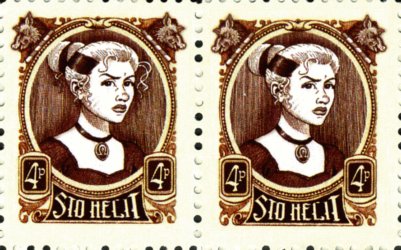
The Common and the Sport.
|


